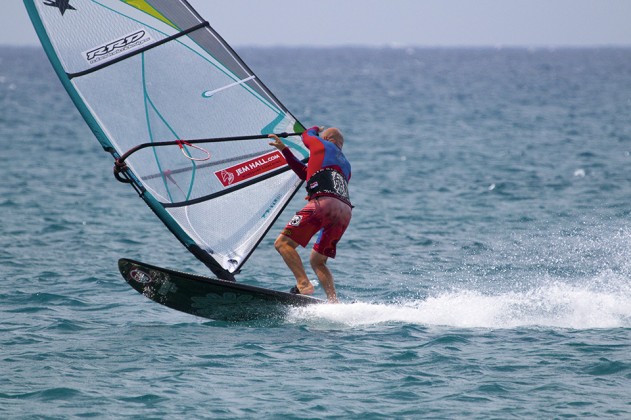JEM HALL
MOVE ON UP – WINDSURFING TECHNIQUE
DIAL IN THE DUCK GYBE
How is all that ‘gybe talking’ and doing going? Hope all the light wind homework and top tips I have been handing out over the last few months have been a good source of information and inspiration. The perspiration does not stop there as now it is time to embrace the duck gybe, and what a wondrous move it is! You have already got a lot of the skills required from your renewed gybing focus and you can duck the rig as you have been banging these out in your light wind training drills.
www.jemhall.com
The Duck gybe is a natural progression from the carve gybe, and has been around our fab sport for 30 years or more, it is old school but feels so so good it will never go out of fashion.
I will breakdown this feature on what the Duck gybe is, who it is for, whyand where we should do it, when to duck the rig and how to go about the whole process. The tips for the relevant stages of the move will be covered in a similar style to last month’s Gybe feature. You can of course get even more info on my fab ‘Beginner to Winner’ Coaching dvd, but then you already knew that.
What
The duck gybe is a great way to turn around downwind while planing and with speed. The sail is changed (ducked) early and then the board is carved / turned out. It is a simpler gybe then the step gybe.
Who
If you are making 30% of your carving step gybes and going into them with speed and getting your sail light then this move is for you. It is also for the thrill seekers and for the people who want to improve faster and enjoy their sailing even more!
Why
This feature is already scattered with a myriad of reasons. It is fun, it will improve you, it keeps you inspired and it feels great. Lastly, it is a little bit scarey and just might yield your first planing gybes – hoorah!
Where
Choose a flatter section of water, either on flat water or between waves. As you nail them, and yes you will AND you can, then go for the duck gybe onto the wave or even off the wave
When
First tip and one of the most important and well used is duck it early. Make the move off the wind (on a broad reach for those in the know) and when the rig is light from your amazing set up and blistering approach speed.
How
As Bruce Lee says ‘don’t think, feel,’ it really does pay not to over think this move and just go for it, after a healthy amount of visualization of course.
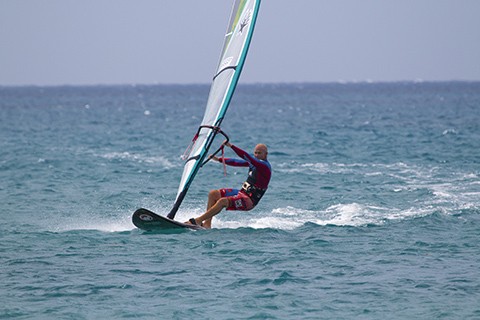
// Get low and prepared, go fast to get the sail light and thereby ready to duck’
Tips to rip through the duck gybes
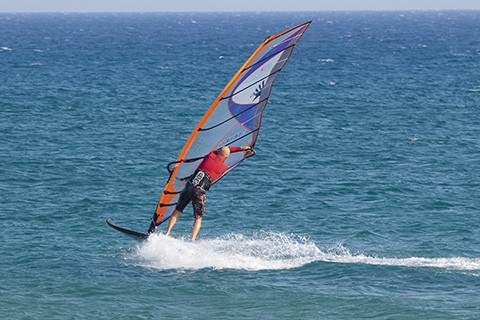
// Tackle the duck gybe challenge and work up to bigger sails’
Kit
Boards that turn well work best like Freestyle Wave and Freemove boards. The sail should not be too big to learn the move, so 6.0 and under is ideal and then once you have it dialled you can use as big as you dare!
Conditions
It is a move to be workedon when low to medium powered, i.e. when you go downwind the sail goes light and is not making you fear for your life. If it is marginal I will often duck gybe as it is more fun and I am more likely to come out planing as I can get the power on again early.
The How Part
The preparation is as per a Carving step gybe, hand back, unhook, get low and bear away using the same steps covered in last month’s Gybe feature.
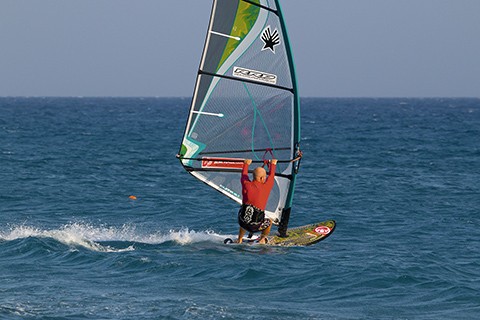
// Get low at the end and this gets you planing and in control
The Duck
• Roll forward into the approach as per a carve gybe to keep the sail light, set the rail and keep the sail ready for ducking.
• Whilst still on a broad reach go for the duck!, going for it early and when the sail is light.
• Front hand releases and crosses over to the very back of the boom, whilst the old back hand tilts rig forward towards the nose of the board. This keeps the mast out of the water, makes the back of the boom available to you and stops you getting dismissed.
• Whip the rig back past your ear like you are wiping sweat from your brow, with your new back hand (old front hand).
• Take on the mantra ‘Duck, pull and look.’
• Pull the rig across you as you look to your exit and get low with your hips across. Honestly, it will feel natural.
• Be aggressive with the pull across, yet subtle in the initial push and positioning of the rig forwards.
• Try to move your free hand towards the water like you are the one handed duck gybe master as this will get you low and dynamic and your hips will naturally shift. All this keeps the board carving.
• Pull the boom hard across you and only grab the boom on the new side when the front of it is available. Patience please and no boom walking!
• On big sails you are actually letting go of the boom and launching it forward pre duck.
• The sail will be hands free at moments in this beautiful move so enjoy these and relax.
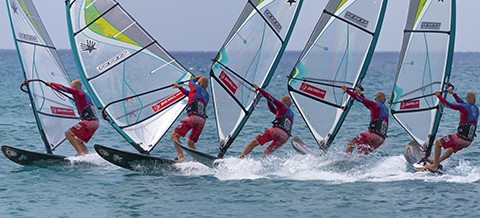
// Gybe off front foot, cross hands, duck, look, pull and then carve and switch feet – do it! – do it!’
The Carve
• The duck part of the move helps you get low and facilitates a smooth carve, further aided by looking at your exit.
• When the boom is in both hands (near the lines) and the arms are extended then you can focus on carving hard through the back foot to take you through the wind to the new direction, broad reach to broad reach.
• Really bend your front ankle and your back leg and imagine pushing your inside knee into the water.
• Feel your arc; go wider when it is windy and you are well powered, go narrower when less powered.
• Think ‘sail away, body low and carve the board.’ This will feel natural as the sail change is done so early.
• It is really important to actively sheet the sail out so as not to get pulled over the handle bars or stall the sail.
• Imagine the rig is moving to the outside as the hips move to the inside, just like a carve gybe.
The Exit
• You are so nearly there now so eyes on the prize.
• Keep spotting your exit (new direction) and as your hips are carving nice and low to the inside then your feet are ready to shift and switch.
• If it is a big board, then change your feet earlier
• If it is a smaller board, then you can come out and sail switch (old front foot still in its original strap) for a while.
• Both of the above are down to personal preference and for me I go for the early feet change.
• Carve out on your heels, as per a gybe.
• Get low and keep the rig away and strap up before hooking in.
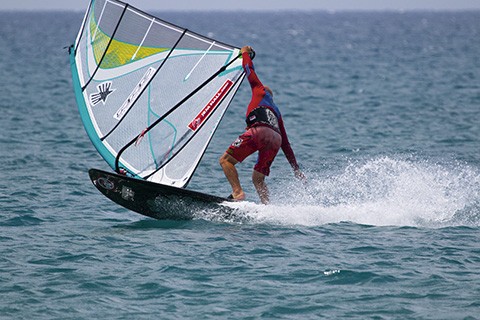
// Try to drag your free hand in the water to add dynamism.
Finally, learn the move in both directions to keep your techniques in balance. This move has a lot going on but like all moves, keep it simple, focus and just go for it. You will have a few crashes but ‘failure is one step towards success’ and you are already ‘comfortable with being uncomfortable.’ The Duck Gybe is a flowing move that I truly love to teach, the more we duck the faster we grow and why we will always want to improve it.
RRD boards, wetsuits, softwear, Ezzy sails and Pro Sport Sunblock sponsor Jem Hall. Get him live and direct on one of his highly acclaimed coaching holidays.


